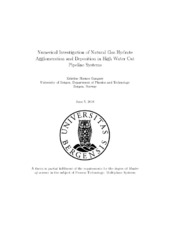| dc.contributor.author | Gangsøy, Kristine Blænes | |
| dc.date.accessioned | 2018-09-04T16:04:47Z | |
| dc.date.available | 2018-09-04T16:04:47Z | |
| dc.date.issued | 2018-06-20 | |
| dc.date.submitted | 2018-06-19T22:00:19Z | |
| dc.identifier.uri | https://hdl.handle.net/1956/18382 | |
| dc.description.abstract | The phenomena of gas hydrate plugging constitute a well known problem in the petroleum production and transport industries. Nevertheless, this issue is still not fully understood, especially for high water cut systems. For mature petroleum fields the amount of water produced increases, which results in increased risk of gas hydrate plug formation in pipelines. From previous work, it is not clear which mechanism is the most dominant for hydrate plug formation in water dominated pipeline systems: increased hydrate slurry viscosity or deposition on the pipeline wall. Knowledge of the mechanism leading to plugging is crucial to obtain efficient and economical risk management strategies for preventing pipeline plugging in such systems in the future. Computational fluid dynamics (CFD) with the discrete element method (DEM), which is an extension of the Lagrangian modelling methodology, was used to examine the flow of gas, hydrates and water in a pipeline. There is a lack of knowledge regarding interactions forces for naturally occurring gas hydrates in previous numerical works. These are key parameters when investigating hydrate agglomeration and deposition. The hydrate-hydrate cohesion force and the hydrate-wall adhesion force have been found from empirical estimates for model hydrates or regarded as unknown in earlier works. The first part of this thesis therefore focuses on finding better estimates for naturally occurring hydrate interaction from experimental findings. By numerical simulations, the corresponding work of cohesion between hydrate particles was found to be W_coh = 7.0 mJ/m^2 and the corresponding work of adhesion to the steel wall material was found to be W_adh = 0.8 mJ/m^2. Furthermore, two different two-dimensional flow systems for investigating the flow were simulated, the fist simulates a stirred tank system, referred to as case 1 and and the second a industrial pipe, referred to as case 2. In case 1, hydrates accumulated at the upper part of the pipe, close to the gas-water interphase, and agglomerates of a wide range of sizes were formed. In case 2, a major hydrate agglomerate was formed in the middle of the pipe. No particle deposition was observed in the simulations due to the shear force from the water phase being too high to allow the particles to adhere to the wall. According to these results, the most probable main mechanism for hydrate plugging in the water phase seems to be hydrate bed formation increasing the hydrate-water slurry viscosity. | en_US |
| dc.language.iso | eng | eng |
| dc.publisher | The University of Bergen | en_US |
| dc.subject | Gas Hydrate Agglomeration | eng |
| dc.subject | plug formation | eng |
| dc.subject | Elementmetoden | nob |
| dc.subject | Gasshydrater | nob |
| dc.subject | Numerisk fluiddynamikk | nob |
| dc.subject | Petroleumsteknologi | nob |
| dc.title | Numerical Investigation of Natural Gas Hydrate Agglomeration and Deposition in High Water Cut Pipeline Systems | en_US |
| dc.type | Master thesis | |
| dc.date.updated | 2018-06-19T22:00:19Z | |
| dc.rights.holder | Copyright the Author. All rights reserved | en_US |
| dc.description.degree | Masteroppgave i prosessteknologi | en_US |
| dc.description.localcode | MAMN-PRO | |
| dc.description.localcode | PRO399 | |
| dc.subject.realfagstermer | https://data.ub.uio.no/realfagstermer/c009931 | |
| dc.subject.realfagstermer | https://data.ub.uio.no/realfagstermer/c032017 | |
| dc.subject.realfagstermer | https://data.ub.uio.no/realfagstermer/c011501 | |
| dc.subject.nus | 752199 | eng |
| fs.subjectcode | PRO399 | |
| fs.unitcode | 12-24-0 | |
